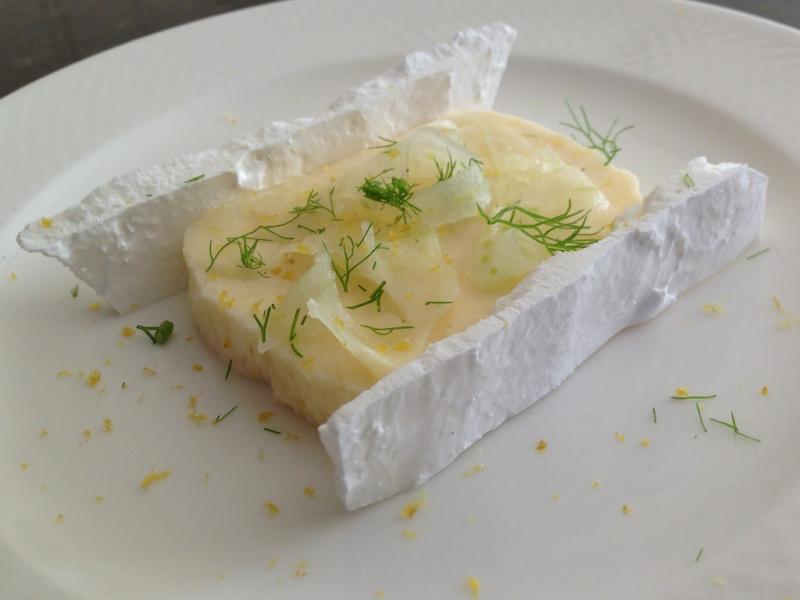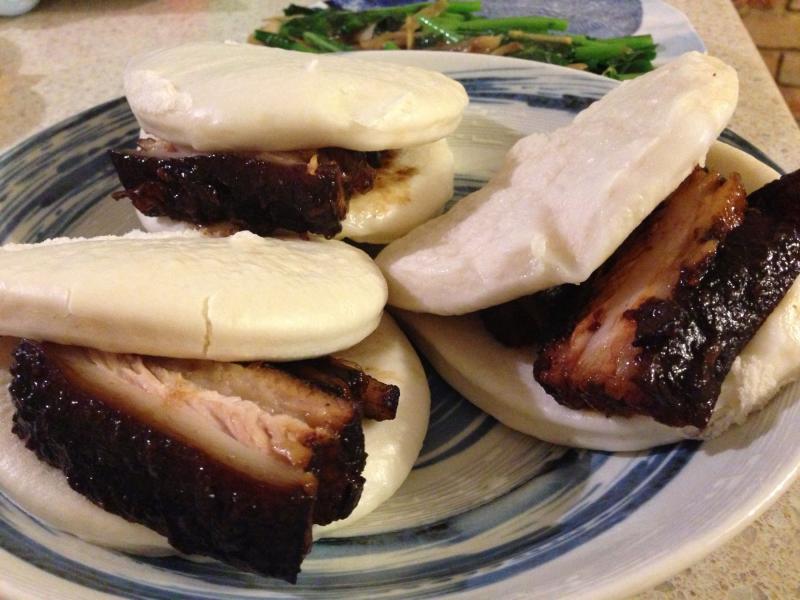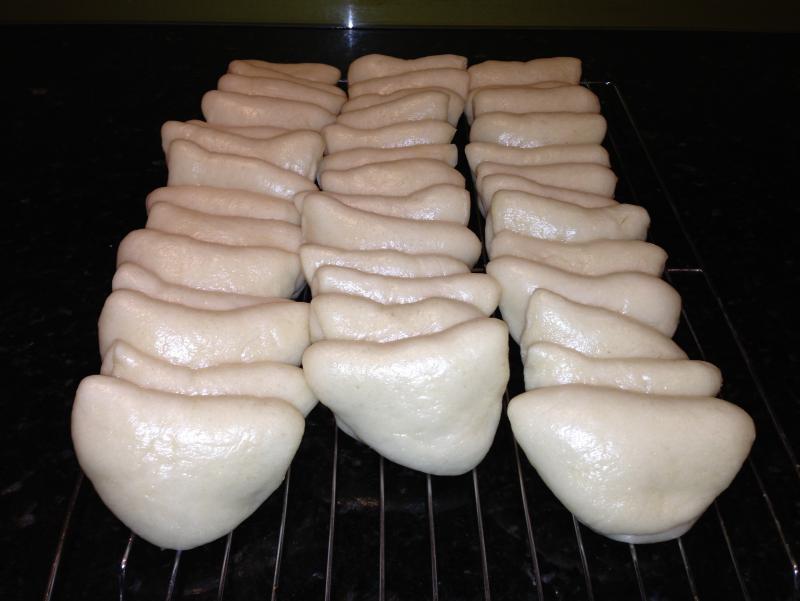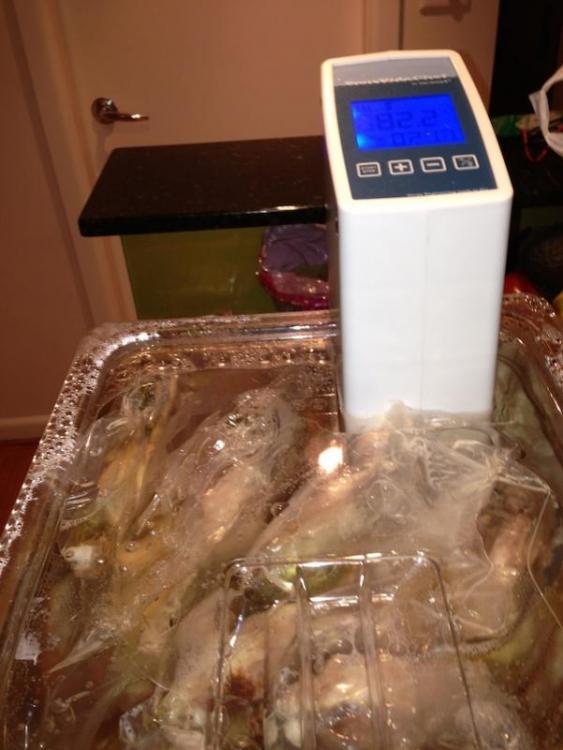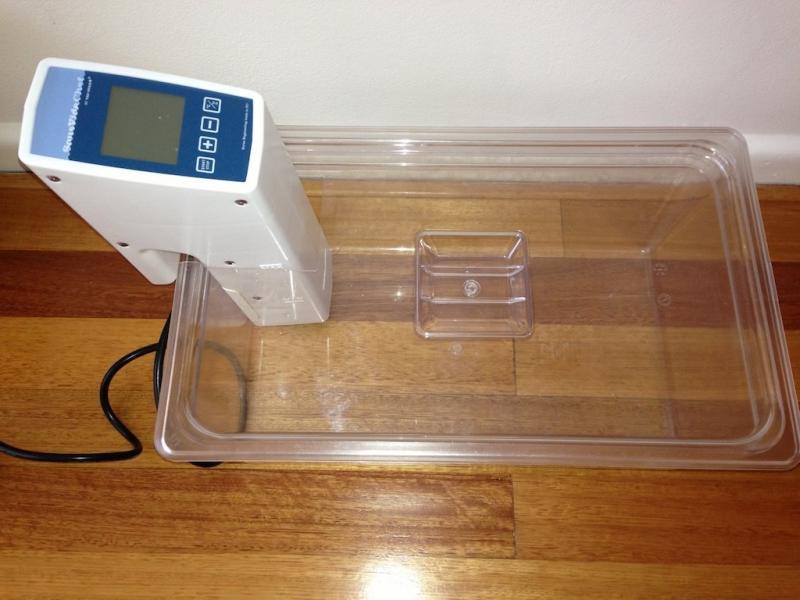-
Posts
2,606 -
Joined
-
Last visited
Content Type
Profiles
Forums
Store
Help Articles
Everything posted by nickrey
-
It was a bit like a very tart lemon meringue pie without the pie crust and with a textural variation with the pickled fennel. The dehydrated meringue was very light, crisp, and sticky all at once. Basically it was an Italian meringue with added lemon juice and zest spread over parchment paper and dried in my dehydrator.
-
Not main course but dessert. My first effort from Sat Bains' new book. Lemon mousse with pickled fennel and dehydrated meringue.
-
I'd be concerned about the clefts that Pedro mentions above. Use boiling water as the time in water only needs to be put in, let go with the tongs, reengage with the tongs, then take out. We are not sterilising, simply reducing potential hazards. Better to wash your hands thoroughly, dunk using tongs, dry off on clean paper towels, keep it away from possible contaminants (eg. chopping boards, bench tops), then place in bag using the tongs. Given that it will be pasteurised anyway, this should deal with contaminants that would survive this process. Because I use a chamber sealer I then fold over the bag and place it in the fridge to cool before sealing. You could also marinate at this stage.
-
Out. Rotuts has a good point. There are bags that go to 120C but I've only seen and bought them for use in a chamber sealer.
-
No, Huiray is right in pointing out that I hadn't read the book. I went in to the book on Amazon preview and far from being In the tone of the review it seems to be a well researched and well argued thesis on the transformation of American dining. The writing is measured and supported by extensive footnotes. Not quite my preferred reading as I am not part of that scene but one that should interest many of the foodies on these forums. The reviewer on the other hand ...
-
Couldn't quote your post RRO as it was in the previous dinner thread but this is the picture. Do you mean I spent all that time making David Chang's recipe when I could have bought them frozen?
-
Cooked two lots of duck confits contiguously. This picture was taken 2 hours before the end of the second lot of cooking (14 hours in). No liquid on device, no condensation. Think it's safe to say that it doesn't do this at high temperatures. Reason there is water around rim is that the container was filled to brim. No evaporation using this container either.
-
Just do a google search for 220g butane gas cartridge. You'll find them easily.
-
Dunk it in boiling water. This will kill the surface bacteria without compromising the sous vide cook. Also make sure that it hasn't been Jaccarded.
-
I frequented a very good Cheesemonger in recent times and often watched him suggesting cheese plates. In doing so he explored the person's preferences as well as those of the guests before making suggestions. So the real answer to the question is, it depends. Typically a cheese platter at a party is not a medium through which to educate people so I'd go better than normal cheeses but safe. At a minimum I'd serve some hard cheese (try to find Vermont or English cheddar if you can), some soft cheese (Brie, Camembert - if you can get exotic cheeses, try to find Brie de Meaux and La Conquerant Camembert) for a hard cooked Cheese try Comte Gruyere, and if people are adventurous put out a soft blue such as Blue Castello. I'd also put out a local cheese that people are used to and may use regularly so those who are conservative have something to nibble on. Accompany it with sourdough and normal baguettes and, if you are using blue, possibly some oatmeal biscuits or fruit loaf. You could also use crackers and wafers If it is the only food at your drinks party, don't go light on the amount of bread that you put out. To go with it serve cut up fresh apple, grapes, figs, nuts (eg walnuts), dried raisins or muscatels, dried fruit (eg. apples), some fruit paste such as quince. Let us now what cheeses you pick and can get and we can suggest drinks to go with them.
-
The best tasting fish is always the one that requires the least added to it to make the final dish. If you can simply cook it gently in butter or olive oil, adding only salt and lemon and it is exquisitely tasty then you have the best tasting fish.
-
Yogurt is so easy to make, why not make your own? I recommend the cultures from New England Cheesemaking but any of the commercial cultures will work, such as Yogourmet and the goat milk carried at Trader Joe's is excellent and you can make it a lot cheaper and can control the "tangyness" by the time it incubates - less time for less "tang" longer incubation if your like it sharper...Following the same procedure using the cultures in cream instead of milk you can then make cultured butter.I make both yoghurt and cultured butter at home. The time involved apart from leaving it in the yoghurt maker (or Thermos after you've heated it to temperature) is minimal and the product far exceeds what you can buy. Add some milk powder to the milk for the yoghurt to make Greek style yoghurt, add fruit to your taste after making the yoghurt. Use skim milk for no fat yoghurt, full milk for full fat. The combinations are many and you will come up with one that suits your needs.
-
Not deconstructionist drivel? Really?I actually thought we ate ethnic food because it was exciting, exotic, and a change from our normal eating habits. To think I was really suppressing my inner prejudices. As a psychologist who tests these sorts of statements for veracity using experiments all I can say is the author is guilty of unsupported assertions using as its basis a socio-political framework that deconstructs the foodie phenomenon. Call it what you will but I'll call it what I did above.
-
The Iwatani torches, which are great by the way (I bought mine from the US and imported it to Australia), use readily available butane gas cylinders such as these. I found some clones of these on UK eBay at around €1.18 each that ship to Europe so even if you can't get them locally, you can source them easily.
-
Reading through the book review there are significant indicators that Pearlman's book is yet another example of deconstructionist drivel. I suspect the book author doesn't see the irony that her approach in relation to more conventional academic analysis echoes closely the position of the very approaches to food that she is decrying in relation to her (presumably) unspecified model of a good approach to food. Perhaps if you are guilty of something yourself you are better at identifying it in others and in other areas.
-

WSJ Articles on Food, Drink, Cooking, and Culinary Culture
nickrey replied to a topic in Food Traditions & Culture
The original didn't have a power cord attached at all. How would it receive the power that it needed to work? From the best of my memory every electrical device I've seen advertised has a picture taken without the power cord: it's more aesthetically pleasing. I don't think the Nomiku people have misled anyone by doing this. As to the finish, it will be interesting to see how similar it is to the advertised prototype. One thing I think we all need to remember that this was a Kickstarter project launched on the basis of a prototype that has subsequently been modified because of issues arising in testing. If the original pictures were of a final version in production, I think there would be grounds to complain but realistically elements were going to change simply because it had not yet even reached the tooling stage. -
I cooked some duck confit with my Sous Vide Chef II at 82.2C for 8 hours with no condensation. This time I've got myself a 22 liter polycarbonate container with a lid that has a square drilled out for the device to sit in. The container is rated for heat from -40C to +100C.
-
The manufacturer's datasheet referenced in the last post has the following statement: "The resolution of the temperature sensor is user-configurable to 9, 10, 11, or 12 bits, corresponding to increments of 0.5°C, 0.25°C, 0.125°C, and 0.0625°C, respectively." If they chose the 12 bit resolution, the Vac-star person would be correct when they said that the resolution was .0625.
-
A number of chefs use oil as a cooking medium similar to what you are proposing. In essence it's a very low temperature confit.
-
How much liquid should be extracted from the legs? Not quite sure what you mean here, can you clarify? Should I include further seasonings in the bags when cooking? Thomas Keller puts some garlic, peppercorns, bay leaves, and thyme in a plastic wrap parcel (tightly wrapped so the herbs don't touch the flesh directly) and vacuum packs it in the bag while cooking. Is 12 hours curing adequate? Yes How long should I let it rest before consumption? I've had them virtually straight away and they are good. Make sure you dry them thoroughly before frying them so the skin doesn't slough off. I'd do this by storing them uncovered overnight in the fridge.
- 4 replies
-
- Charcuterie
- French
-
(and 1 more)
Tagged with:
-
See this post for Nathan Myhrvold's discussion of this.
-
Looking at the bottle. The sugar is 2% and fructose 1%. These are hardly large proportions. Moreover, as fish sauce is used as a salting element in the sweet, sour, salty, piquant mix of Asian foods the addition of a bit of sweetener in these levels is hardly going to impact on its appeal in the final dish. I'd have to say in tasting it compared with other fish sauces in my pantry, it's somehow smoother and more rounded yet still salty. A while back I made up some prawn stock and reduced the hell out of it. I then added some salt. On tasting it, I thought I'd ruined it. However, having tasted these fish sauces made from anchovies the salt level is similar. The prawn has a similar salinity level but a much better flavour. I'm going to use it in some Thai dishes to check out how it goes in cooking. ps. It costs around $4 for a 200g bottle here and can be found cheaper if you are willing to search.
-
The megachef brand was created by the son of the founder of Squid brand sauce. It is sometimes referred to as "son of squid."
-
But it's so easy to sharpen, why not if you have the tools and skill This comment was in response to Keith's comment above that you can't sharpen the blade on a Benriner. Actually taking mine out, it would be easy enough to remove the blade and sharpen it on stones, so I agree with you.
-
David Thompson has recommended the Megachef brand (he's the brand ambassador). Andrea Nguyen's review of the sauce can be found here. I've used it and it is very good and available in Sydney.


